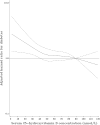Race, vitamin D-binding protein gene polymorphisms, 25-hydroxyvitamin D, and incident diabetes: the Atherosclerosis Risk in Communities (ARIC) Study
- PMID: 25926504
- PMCID: PMC4441813
- DOI: 10.3945/ajcn.115.107334
Race, vitamin D-binding protein gene polymorphisms, 25-hydroxyvitamin D, and incident diabetes: the Atherosclerosis Risk in Communities (ARIC) Study
Abstract
Background: Low 25-hydroxyvitamin D [25(OH)D] is associated with diabetes, but few studies have examined racially diverse populations while also accounting for key vitamin D-binding protein (DBP) gene polymorphisms.
Objective: We sought to evaluate whether the association between 25(OH)D and incident diabetes varied by race and important DBP single nucleotide polymorphisms (SNPs).
Design: We studied 10,222 adults (8120 whites, 2102 blacks) aged 46-70 y at baseline (1990-1992) from the ARIC (Atherosclerosis Risk in Communities) Study with follow-up for incident diabetes ascertained during study visits conducted in 1993-1995 and 1996-1998. Adjusted HRs and their 95% CIs for diabetes were estimated according to 25(OH)D status.
Results: During follow-up there were 750 incident cases of diabetes. The association of 25(OH)D with diabetes varied by race (P-interaction = 0.004). Among whites, the adjusted HR for diabetes corresponding to each additional SD higher 25(OH)D concentration (21.3 nmol/L) was 0.95 (95% CI: 0.91, 0.99). No significant association was observed among blacks (HR: 1.06; 95% CI: 0.99, 1.14). There was evidence that the A allele at rs4588 and the T allele at rs7041, which are reported to be associated with high and low DBP concentrations, respectively, modified the association between 25(OH)D and diabetes among whites (P-interaction < 0.05 for both) but not blacks (P-interaction > 0.50 for both).
Conclusions: In this large, community-based study, low 25(OH)D concentrations were associated with diabetes among whites but not blacks. Interactions by key DBP SNPs varied between genotypes associated with either high or low DBP concentrations among whites but not blacks. Nevertheless, the findings from this prospective study suggest that there are important differences in the association of 25(OH)D with incident diabetes between white and black adults.
Keywords: cohort study; diabetes; race; vitamin D binding protein polymorphisms.
© 2015 American Society for Nutrition.
Figures


Similar articles
-
25-hydroxyvitamin D levels, vitamin D binding protein gene polymorphisms and incident coronary heart disease among whites and blacks: The ARIC study.Atherosclerosis. 2015 Jul;241(1):12-7. doi: 10.1016/j.atherosclerosis.2015.04.803. Epub 2015 Apr 25. Atherosclerosis. 2015. PMID: 25941991 Free PMC article.
-
Vitamin D, vitamin D binding protein gene polymorphisms, race and risk of incident stroke: the Atherosclerosis Risk in Communities (ARIC) study.Eur J Neurol. 2015 Aug;22(8):1220-7. doi: 10.1111/ene.12731. Epub 2015 May 12. Eur J Neurol. 2015. PMID: 25962507 Free PMC article.
-
The associations of 25-hydroxyvitamin D levels, vitamin D binding protein gene polymorphisms, and race with risk of incident fracture-related hospitalization: Twenty-year follow-up in a bi-ethnic cohort (the ARIC Study).Bone. 2015 Sep;78:94-101. doi: 10.1016/j.bone.2015.04.029. Epub 2015 Apr 25. Bone. 2015. PMID: 25920689 Free PMC article.
-
Race and Vitamin D Binding Protein Gene Polymorphisms Modify the Association of 25-Hydroxyvitamin D and Incident Heart Failure: The ARIC (Atherosclerosis Risk in Communities) Study.JACC Heart Fail. 2015 May;3(5):347-356. doi: 10.1016/j.jchf.2014.11.013. Epub 2015 Apr 8. JACC Heart Fail. 2015. PMID: 25863973 Free PMC article.
-
Vitamin D Binding Protein Impact on 25-Hydroxyvitamin D Levels under Different Physiologic and Pathologic Conditions.Int J Endocrinol. 2014;2014:981581. doi: 10.1155/2014/981581. Epub 2014 Apr 28. Int J Endocrinol. 2014. PMID: 24868205 Free PMC article. Review.
Cited by
-
Vitamin D and Cardiovascular Disease: Can Novel Measures of Vitamin D Status Improve Risk Prediction and Address the Vitamin D Racial Paradox?Curr Cardiovasc Risk Rep. 2017 Jan;11(1):3. doi: 10.1007/s12170-017-0528-7. Epub 2017 Jan 21. Curr Cardiovasc Risk Rep. 2017. PMID: 28261371 Free PMC article.
-
25-hydroxyvitamin D levels, vitamin D binding protein gene polymorphisms and incident coronary heart disease among whites and blacks: The ARIC study.Atherosclerosis. 2015 Jul;241(1):12-7. doi: 10.1016/j.atherosclerosis.2015.04.803. Epub 2015 Apr 25. Atherosclerosis. 2015. PMID: 25941991 Free PMC article.
-
Vitamin D Status and Kidney Function Decline in HIV-Infected Men: A Longitudinal Study in the Multicenter AIDS Cohort Study.AIDS Res Hum Retroviruses. 2017 Nov;33(11):1140-1148. doi: 10.1089/AID.2017.0009. Epub 2017 Sep 5. AIDS Res Hum Retroviruses. 2017. PMID: 28756682 Free PMC article.
-
25-Hydroxyvitamin D Status and Risk for Colorectal Cancer and Type 2 Diabetes Mellitus: A Systematic Review and Meta-Analysis of Epidemiological Studies.Int J Environ Res Public Health. 2017 Jan 28;14(2):127. doi: 10.3390/ijerph14020127. Int J Environ Res Public Health. 2017. PMID: 28134804 Free PMC article.
-
Vitamin D deficiency is independently associated with greater prevalence of erectile dysfunction: The National Health and Nutrition Examination Survey (NHANES) 2001-2004.Atherosclerosis. 2016 Sep;252:61-67. doi: 10.1016/j.atherosclerosis.2016.07.921. Epub 2016 Jul 29. Atherosclerosis. 2016. PMID: 27505344 Free PMC article.
References
-
- DeLuca HF. Overview of general physiologic features and functions of vitamin D. Am J Clin Nutr 2004;80(6 Suppl):1689S–96S. - PubMed
-
- Holick MF. Vitamin D deficiency. N Engl J Med 2007;357:266–81. - PubMed
-
- Chiu KC, Chu A, Go VL, Saad MF. Hypovitaminosis D is associated with insulin resistance and beta cell dysfunction. Am J Clin Nutr 2004;79:820–5. - PubMed
-
- Scragg R, Holdaway I, Singh V, Metcalf P, Baker J, Dryson E. Serum 25-hydroxyvitamin D3 levels decreased in impaired glucose tolerance and diabetes mellitus. Diabetes Res Clin Pract 1995;27:181–8. - PubMed
Publication types
MeSH terms
Substances
Grants and funding
LinkOut - more resources
Full Text Sources
Other Literature Sources
Medical

